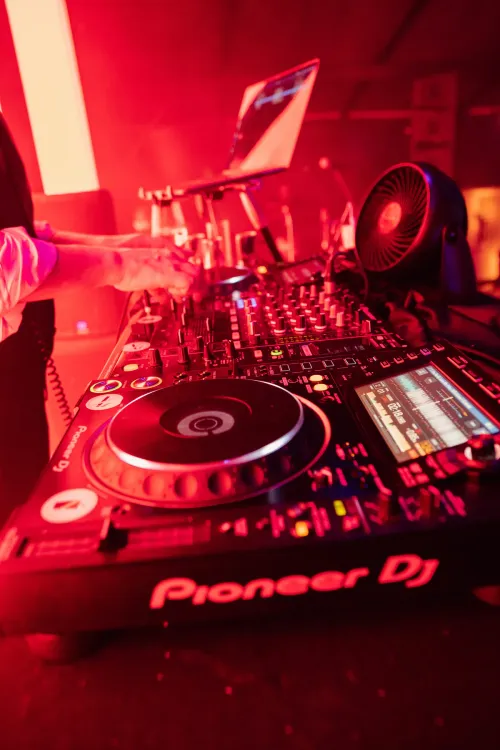Distortion in music production is a technique used to alter the sound of musical instruments or vocals, often adding richness, warmth, and texture. It is crucial in various genres to create specific sonic characteristics that define a song's emotional and aesthetic appeal.
What is Distortion and How Does it Work?
Distortion occurs when an audio signal exceeds a device's or system's limits, causing the waveform to clip or change shape. Originally considered undesirable, it has become a creative tool in music production.
At its core, distortion is about pushing an audio signal beyond its clean, undistorted state, which introduces additional harmonics and alters the original sound. This effect can be achieved in various ways: through analog gear like tube amplifiers and pedal effects or digitally via software plugins.
When a sound wave is distorted, it essentially means the smooth curves of the wave become more abrupt or "clipped." This clipping, whether soft or hard, generates new frequencies that weren't part of the original sound.
Soft clipping gently flattens the peaks, producing a warmer, more subtle form of distortion, while hard clipping cuts off the peaks more abruptly, resulting in a harsher, more aggressive sound.
Types of Distortion
There are many different types of distortion - here's an explanation of several forms:
Harmonic Distortion
Harmonic distortion enriches a sound by adding overtones, creating a fuller and warmer audio experience.
Example: Kendrick Lamar's "HUMBLE." features harmonic distortion on the vocals and bass, adding to the track's intensity:
When to Use: Harmonic distortion is ideal for adding warmth and fullness to sounds that may feel too thin or digital. It works well on vocals, bass, and even full mixes to add a sense of richness.
How to Use: Apply it subtly to avoid overwhelming the original sound, focusing on enhancing the harmonics rather than altering the sound completely.
Clipping
Clipping shears off the peaks of an audio signal creating a distorted, aggressive sound.
Example: The Beatles' "Revolution" uses clipping on the guitars, delivering a raw, powerful sound that was groundbreaking for its time.
When to Use: Clipping is great for aggressive musical styles like rock, metal, and edgy electronic music. It can give drums, bass, and electric guitars a raw, powerful edge.
How to Use: Use it with caution; too much clipping can lead to an unpleasant listening experience. It's often best used on individual tracks rather than the whole mix.
Saturation
Saturation is a soft, often pleasing form of distortion that originates from driving analog tape or tube amps, adding warmth and depth.
Example: Tame Impala's "The Less I Know The Better" uses saturation to achieve its lush, psychedelic sound.
When to Use: Saturation suits almost any element of a track where you want to introduce warmth and analog character. It’s especially effective on vocals, drums, and master tracks to glue the mix together.
How to Use: Start with light saturation and increase it until you notice the warmth without overt distortion, maintaining the integrity of the original sound.
Fuzz
Fuzz is an intense form of distortion that creates a thick, sustained sound by heavily clipping the signal.
Example: Jimi Hendrix's "Foxy Lady" showcases fuzz distortion on the guitar, a seminal example of its use in rock music.
When to Use: Fuzz is perfect for creating a bold, statement sound on guitars, bass, or synths. It suits genres like rock, psychedelic, and certain types of electronic music.
How to Use: Fuzz can be quite overwhelming, so it’s often best used on solos or specific sections to highlight them rather than as a constant effect.
Sample Rate Distortion
Sample Rate Distortion, caused by recording audio with too few samples per second, can introduce unique, gritty textures to the sound, beneficial for creating lo-fi or vintage effects.
Example: Aphex Twin's "minipops 67 [120.2][source field mix]" uses sample rate distortion to create its unique, glitchy textures.
When to Use: This is ideal for achieving a lo-fi, vintage, or glitchy effect, making it suitable for electronic music, hip-hop, and any genre that benefits from a bit of grit.
How to Use: Experiment by applying it to leads, drums, or even vocal samples to add texture. Be mindful of the overall mix, as it can quickly become too harsh.
Phase Distortion
Phase Distortion tweaks the timing of sound waves to create new tones, which can be useful for adding richness and complexity to electronic music.
Example: Flume's "Helix" uses phase distortion for its synths, creating a futuristic sound.
When to Use: Use phase distortion to add uniqueness to synth lines or pads in electronic music, creating sounds that stand out in a mix.
How to Use: Apply it to synths or background elements to add movement and depth without overwhelming the main components of your track.
Bitcrushing
Bitcrushing reduces digital audio's bit depth, introducing quantization noise and a distinctive, gritty texture.
Example: While primarily a digital effect, early examples of bitcrushed sounds can be found in 8-bit video game music, such as the theme for "Super Mario Bros.," influencing various genres.
When to Use: Bitcrushing is excellent for electronic music, chiptune, or any production looking for a retro digital edge. It works well on drums, synths, and effects.
How to Use: Start with a small amount and adjust until you find the sweet spot where the texture is noticeable but not detracting from the sound's core quality.
Overdrive
Overdrive simulates the warm distortion of an overdriven tube amp, creating a dynamic, smooth distortion.
Example: Arctic Monkeys' "Do I Wanna Know?" features overdriven guitars that give the track a sultry, powerful groove.
When to Use: Overdrive is versatile, suitable for gently pushing elements like guitars, pianos, and even vocals into a warmer, more vibrant space.
How to Use: Use overdrive to subtly enhance the natural harmonics of the sound. It’s particularly effective in blues, rock, and any genre where a natural, organic warmth is desired.
FAQs
How do I choose the right type of distortion for my track?
Consider the vibe and genre of your track. Harmonic distortion and saturation can warm up sounds, making them great for almost any genre. Fuzz and clipping provide an aggressive edge suitable for rock or electronic music. Bitcrushing and sample rate distortion are perfect for adding a retro or lo-fi quality.
Can distortion be used on any instrument?
Yes, distortion can be applied to a wide range of instruments. However, how and when you use it depends on the desired effect. For instance, harmonic distortion can enhance vocals or bass, while overdrive might be better suited for guitars.
Is there a risk of overusing distortion?
Yes. Overuse can muddy your mix, making it sound cluttered and undefined. Use distortion purposefully and sparingly, especially when starting out, to ensure each application enhances rather than detracts from the overall sound.
Can distortion be used in mixing and mastering?
Yes, but with caution. A touch of saturation can glue a mix together, and harmonic distortion can add warmth to the master. However, these effects should be applied subtly to avoid compromising the clarity and balance of the mix.
How does digital distortion differ from analog distortion?
Analog distortion, from tube amps or tape, often adds a warm, natural character to the sound. Digital distortion, achieved through plugins or digital hardware, can range from emulating analog warmth to creating harsh digital effects like bitcrushing. The choice between digital and analog depends on the desired outcome and available tools.
What's the best way to learn about using distortion?
Experimentation is key. Try different types of distortion on various instruments and settings to hear their effects firsthand. Listening to music and identifying the types of distortion used can also provide valuable insights.
Can distortion fix a poor recording?
While distortion can mask some flaws by adding harmonics or grit, it's generally not a solution for a poor-quality recording. Addressing issues at the source, such as re-recording or cleaning up the audio with EQ or noise reduction, is preferable.
Can I use multiple types of distortion on one track?
Yes, layering different types of distortion can create unique and complex sounds. However, this requires careful balancing to ensure the track remains clear and each element complements the others.
What is the history of distortion in music?
The history of distortion in music traces back to the early 20th century, initially emerging as an unintended consequence of amplifying instruments, which musicians discovered could add a warm, fuzzy texture to their sound.
This serendipitous discovery in the 1930s gradually evolved into a deliberate artistic tool, with the 1950s and 1960s seeing rock and blues artists like The Kinks and The Rolling Stones popularizing the distinct, gritty edge that distortion provided to their guitar riffs.
The creation of distortion pedals further revolutionized its use, offering musicians a new level of control and consistency in achieving their desired sound.
By the 1970s and 1980s, distortion became a defining element of heavy metal and punk, synonymous with the raw power and aggression of these genres.
The digital era expanded the scope of distortion with techniques like bitcrushing, broadening its appeal across various music styles, including electronic and hip-hop.
Today, distortion is celebrated for its ability to impart texture, character, and emotional depth to music, embodying the innovative spirit of turning technical limitations into expressive opportunities.








